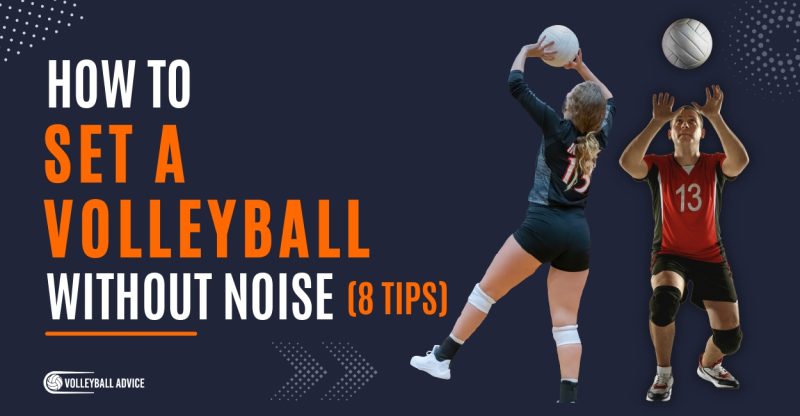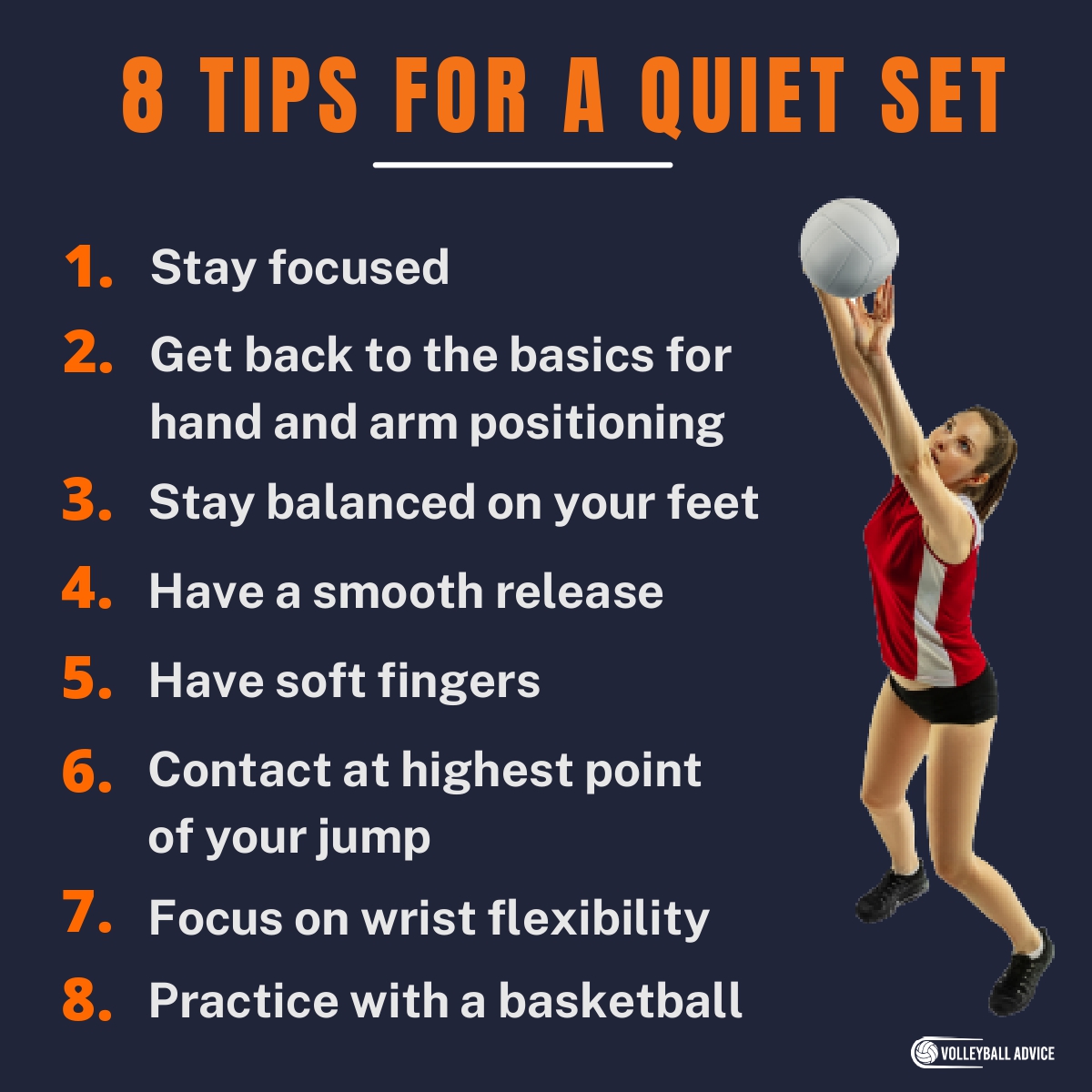How To Set a Volleyball Without Noise (8 Tips)
Setting a volleyball without noise is an elite skill that only the best players achieve.
It is not only a demonstration of a setter’s brilliance, but a beneficial skill that when combined with flawless form, gives the opposing team no hint of where the set may be going. The lack of noise also eliminates the possibility for it to be called for a double touch or “mis-set”, as referees call this both by noise and watching the ball for backspin. A silent set will have neither of these things.
How do you set a volleyball without noise? To set a volleyball without noise, a setter must have “soft hands” – in other words, flawless technique with fingers that lightly caress the ball when touching and releasing, moving so smoothly that the firm, deliberate contact appears fluid – and perfectly maintained balance. This will help reduce noise.
Below, I’ll be breaking down helping you understand what a silent set means, why it happens, and how to do it.
Is Setting A Volleyball Silently Hard?
Setting a volleyball without noise is not an easy thing to do, and not something that you can learn overnight. In truth, it’s one of very few casually discernable marks of excellence displayed by top setters that results from years – if not decades – of practice and familiarity with the ball.
However, setting like this takes serious concentration, and even the best setters cannot set noiselessly forever.
There are many setters out there who can claim to set noiselessly, but setting one ball outside of drills silently is very different from setting like that in a match. With good technique and a razor sharp focus, perhaps you also will achieve these “ghost sets”.
What Makes the Set Silent?
A silent set is so quiet because the ball has no spin and there was no impact of the ball on the setter’s hands.
Before we can get into what that means, we need to break down some new volleyball terms.
We have two words for touching the ball in volleyball: contact and impact.
- Contact is simple, it only refers to anytime you touch the ball, whether that’s deliberate or otherwise. Even if the ball grazes you, it counts as a contact.
- Impact refers to hard contact or anytime a player redirects a ball by putting their body at an angle to it. And as we know from spiking, impact causes noise.
So where does silent setting come in?
Setting itself is clearly an impact touch, as it redirects the ball . . . or is it? We’ll get there in a moment.
Ideally, the perfect set is meant to redirect the ball by barely touching it, with no spin, having touched a single surface, and having touched the setter’s hands for only a fraction of a second – faster than most people can move. While this is unattainable, the silent set is the closest we can come to reaching this “perfect set” in volleyball.
A silent set moves in tandem with the ball, allowing the ball to sink perfectly into one’s hands at the same speed as it’s moving, receiving its momentum through the wrists, and redirecting it immediately with a clean release.
In other words, there was no impact – hard contact. The setter’s touch here is so fluid that it looks soft; that’s why we refer to perfect setter hands as “soft hands”.
Because there’s no impact, there’s no noise, and because there’s no friction or superfluous contact, there’s no spin. All that occurs is a true redirection of the ball.
A silent set is as close to the theoretical “perfect set” in volleyball as is attainable, requiring skill, experience, and focus, and is much harder to execute than spiking on the ten foot line or diving for a ball.
Knowing this should make it one of the most impressive things to watch whenever you see it.
Is It Important To Set A Volleyball Without Noise?
While the theoretical “perfect set” implies that it would be silent, there’s nothing actually wrong with setting a volleyball with noise. As long as it doesn’t have spin, goes where you want it, and you haven’t broken the rules by double-touching, that’s all you really need to set.
Rather than being an important aspect of setting, the lack of noise is actually just a byproduct of excellent setting ability. While it does offer some benefits, by far the primary concerns remain the same as normal setting: does it spin and where is it going?
You don’t need to set quietly to be a good setter, but a great setter does so because they’re great.
8 Tips For A Quiet Set
My top 8 tips for setting a volleyball without noise are:
- Stay focused
- Get back to the basics for hand and arm positioning
- Stay balanced on your feet
- Have a smooth release
- Have soft fingers
- Contact at highest point of your jump
- Focus on wrist flexibility
- Practice with a basketball
1. Stay Focused
My coach had many sayings, but his favorite for setting was this: “Quiet set, quiet mind.”
The most important thing for a setter to train while improving is their mind. Volleyball is intensely a mental sport, and focus and willpower make up the arsenal of the setter.
Remaining focused on your task is crucial to setting quietly, and you will not be able to do it without this. Use visualization if it helps or focus on your breathing to clear your mind.
2. Get Back To The Basics For Hand & Arm Positioning
If you’re seeking improvement, it’s time to head back to basics.
Practice everything from the ground up, starting with your hand positioning to arm extension, and even how you jump and move to the set. This time around, focus on precision – everything must be perfect. Do not settle for adequate.
What you’re looking for here is a deeper connection with the ball. Feel how it fits to your hand, and find how you can make it better. Practice smooth connections and release, understanding that those are what contribute the most to noise and spin. Every setter has their process, so find yours and stick to it.
3. Stay Balanced on Your Feet
This particular advice is incredibly understated, but is so important for setters. An off-balance setter is not a happy setter – it’s someone who feels like they’re flying sideways through the air.
Remaining balanced will bring your entire technique together and allow you as a setter to put the ball where you want it more easily.
This is absolutely essential to setting silently, and the easiest way to stay balanced is to get to the ball early. That way, you have time to adjust rather than lunging at the last minute at it.
4. Have A Smooth Release
Staying balanced allows for a smooth release, which ensures that the set is silent and where attempts most often go wrong.
Setters, you’ll find that your arms come into play much more than you’re used to when training yourself to set quietly. Your elbows will likely be wider and your shoulders more open, but this is a sign of your set evolving towards a full-body motion. This is a good thing.
5. Have Soft Fingers
Having good technique with fingers that lightly caress the ball is a mark of a great setter. Make your sets look soft, and they will also have the side effect of feeling soft when you perform them.
Sadly, the only avenue to reach this is practice, practice, practice! Imagine yourself as a pillow, absorbing as much impact as possible until the ball just smoothly rests in your fingers – then release!
6. Contact at Highest Point of Your Jump
This is important from a setting technique perspective, and as the silent set is the culmination of mastering setting technique, chances are you’re going to need this to master that as well.
When jump setting, you shouldn’t be aiming to jump as high as possible like you would for blocking or spiking. Aim for a sustainable, medium height jump and incorporate that into your jump set instead. Aim to contact the ball at the highest point of your jump or just before, which will keep you balanced mid-air and allow you to transfer power to the ball.
Move right underneath the ball before you jump, and keep your form nice and tight throughout. Remember: efficiency over expediency when it comes to setting – it’s better to be there at the right time rather than work twice as hard. Find that perfect window for jumping, and your setting will become easier.
7. Focus On Wrist Flexibility
To perform at advanced levels, remember to stretch regularly and do wrist flexibility exercises to warm up.
Finger flexibility is less important but still good to practice during warm up, and if you haven’t yet, you’ll soon find that even your fingers can get exhausted by the end of practice. Avoid hand and finger cramps by stretching and doing light drills by yourself, and alternate heat and ice if you feel any pain later that day.
8. Practice With A Basketball
Last but not least, my advice to help set quietly is to practice with a basketball. The extra weight and width will force slightly wider technique and strong fingers, and when you return to using a volleyball it will feel as light as a feather.
Try to run through some simple setting with a friend or against a wall at least twice a week, or before practice every day if you can manage it.
Check out this guide: Hand Position For Setting In Volleyball (7 Steps)
Final Thoughts: How Long Does It Take To Learn How To Set a Volleyball Silently?
I wish I could say “practice setting with a basketball every day for two years” and you will be able to set silently, but while this may be the case for some people it won’t be for others.
The real answer is that it will take you a lifetime to learn. For new setters, you need the years of experience that lie ahead of you, and for experienced players you need that constant practice and repetition that enables you to perform at the high levels you do.
On the upside, that’s good news! It means that there’s always something to work on and strive for if you want, and it’ll always be there to work on when you want to come back to it. Setting quietly also has absolutely no impact on how much fun volleyball is to play and mess around with, so don’t let it affect the sport that you know and love negatively.
At the end of the day, we play volleyball because it’s fun! Whether it’s learning cool tricks or playing sick games, we get out of volleyball what we put into it. And hey, having a super quiet ninja set up our sleeve . . . ? That’d be pretty cool too.
Other Setting Resources
- Types of Sets In Volleyball: 18 Types Explained + How To Use
- How To Set A Volleyball Without Hurting Your Fingers: 5 Tips
- Footwork For Setting A Volleyball: Technique, Drills, Errors
- The Setter Volleyball Position – 5 Marks Of A Great Player
- 4 Keys To Being The Best Setter You Can Be
About The Author
Ailan Samuel is a writer and athlete who has played volleyball at the university, club, and national level since 2012. He has competed successfully in both beach and indoor competitions, resulting in four silver and two gold medals, and was awarded the Half-Blue while playing in Scotland. He received his MA in English and Medieval History from the University of St Andrews, Scotland, and is currently studying for his MA in Publishing and Creative Writing at Bournemouth University.


